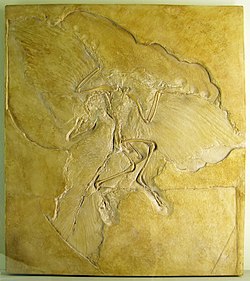| Archaeopterygidae Temporal range: Possible Middle Jurassic and Early Cretaceous records if Anchiornithids are a subfamily. | |
|---|---|
 | |
| Berlin specimen of Archaeopteryx lithographica | |
| Scientific classification | |
| Kingdom: | Animalia |
| Phylum: | Chordata |
| Class: | Reptilia |
| Clade: | Dinosauria |
| Clade: | Saurischia |
| Clade: | Theropoda |
| Clade: | Paraves |
| Family: | † Archaeopterygidae Huxley, 1871 (conserved name) |
| Type species | |
| † Archaeopteryx lithographica von Meyer, 1861 (conserved name) | |
| Genera and possible subfamily [1] | |
| Synonyms | |
| |
Archaeopterygidae is a group of paravian dinosaurs, known from the latest Jurassic and earliest Cretaceous of Europe. In most current classifications, it contains only the genera Archaeopteryx and Wellnhoferia . As its name suggests, Protarchaeopteryx was also once referred to this group, but most paleontologists now consider it an oviraptorosaur. Other referred genera, like Jurapteryx , Wellnhoferia , and "Proornis", are probably synonymous with Archaeopteryx (the former two) or do not belong into this group (the last). Jinfengopteryx was originally described as an archaeopterygid, though it was later shown to be a troodontid. [3] [4] [5] A few studies have recovered Anchiornis and Xiaotingia (usually considered part of a distinct clade, Anchiornithidae) to also be members of the Archaeopterygidae, [6] though most subsequent analyses have failed to arrive at the same result. Uncertainties still exist, however, and it may not be possible to confidently state whether archaeopterygids are more closely related to modern birds or to deinonychosaurs barring new and better specimens of relevant species. [7] Teeth attributable to archaeopterygids are known from the earliest Cretaceous (Berriasian) Cherves-de-Cognac locality and the Angeac-Charente bonebed of France. [8] [9]









